Energy Management of Low-Pressure Systems Utilizing Pump-Unloading Valve and Accumulator
Abstract
1. Introduction
1.1. Constant Pressure Systems
1.2. Low Pressure Systems
2. Proposed Architecture
2.1. Accumulator-Sense Pump-Unloading Valve
2.2. Low Pressure Circuit Implementation
2.3. Split Low-Pressure Accumulator-Sense Pump-Unloading (ASPU) System
3. Reference System
3.1. System Modeling
3.2. Representative Duty Cycles
4. Results
5. Conclusions
Author Contributions
Funding
Acknowledgments
Conflicts of Interest
References
- Lynch, L.; Zigler, B.T. Estimating Energy Consumption of Mobile Fluid Power in the United States; NREL/TP-5400-70240; National Renewable Energy Lab. (NREL): Golden, CO, USA, 2017. [Google Scholar] [CrossRef][Green Version]
- Keller, N.J. A 21st Century Approach to Hydraulic Actuation Technology; Purdue University: West Lafayette, IN, USA, 2017. [Google Scholar]
- Dengler, P.; Geimer, M.; Baum, H.; Schuster, G.; Wessing, C. Efficiency Improvement of a Constant Pressure System Using an Intermediate Pressure Line. In Proceedings of the 8th International Fluid Power Conference, Dresden, Germany, 26–28 March 2012; Volume 1, pp. 567–578. [Google Scholar]
- Dreher, T. The Capability of Hydraulic Constant Pressure Systems with a Focus on Mobile Machines; Ivantysynova, M., Klop, R., Eds.; FPNI Fluid Power Net Publications: Modena, Italy, 2010; pp. 579–588. [Google Scholar]
- Vukovic, D.I.M.; Leifeld, M.S.R.; Murrenhoff, I.H. STEAM- A Hybrid Hydraulic Architecture for Excavators. In Proceedings of the 10th International Fluid Power Colloquium, Dresden, Germany, 8–10 March 2016; Technical University Dresden: Dresden, Germany, 2016; Volume 3, pp. 151–162. [Google Scholar]
- Cundiff, J.S. Fluid Power Circuits and Controls: Fundamentals and Applications; Mechanical Engineering Series; CRC Press: Boca Raton, FL, USA, 2002. [Google Scholar]
- Zavadinka, P.; Grepl, R. Energy Saving Potential of a Hydrostatic Drivetrain with Variable Charge Pump. In Proceedings of the 8th FPNI Ph.D. Symposium on Fluid Power, Lappeenranta, Finland, 11–13 June 2014; American Society of Mechanical Engineers: Lappeenranta, Finland, 2014; p. V001T02A009. [Google Scholar] [CrossRef]
- Keller, N.; Ivantysynova, M. A New Approach to Sizing Low Pressure Systems. In Proceedings of the ASME/BATH 2017 Symposium on Fluid Power and Motion Control, Sarasota, FL, USA, 16–19 October 2017; American Society of Mechanical Engineers: Sarasota, FL, USA, 2017; p. V001T01A071. [Google Scholar] [CrossRef]
- Nervegna, N. Oleodinamica e Pneumatica, Febbraio 2003; Sistemi; Politecnico di Tornino: Turin, Italy, 2003; Volume 1. [Google Scholar]
- Zimmerman, J.D. Toward Optimal Multi-Actuator Displacement Controlled Mobile Hydraulic Systems. Ph.D. Thesis, Purdue University, West Lafayette, Indiana, 2012. [Google Scholar]
- Mikeska, D.; Ivantysynova, M. A Precise Steady-State Model of Displacement Machines for the Application in Virtual Prototyping of Power-Split Drives. In Proceedings of the 2nd International FPNI-PhD Symposium on Fluid Power, Modena, Italy, 3–6 July 2002; FPNI Fluid Power Net Publications: Modena, Italy, 2002; pp. 3–6. [Google Scholar]
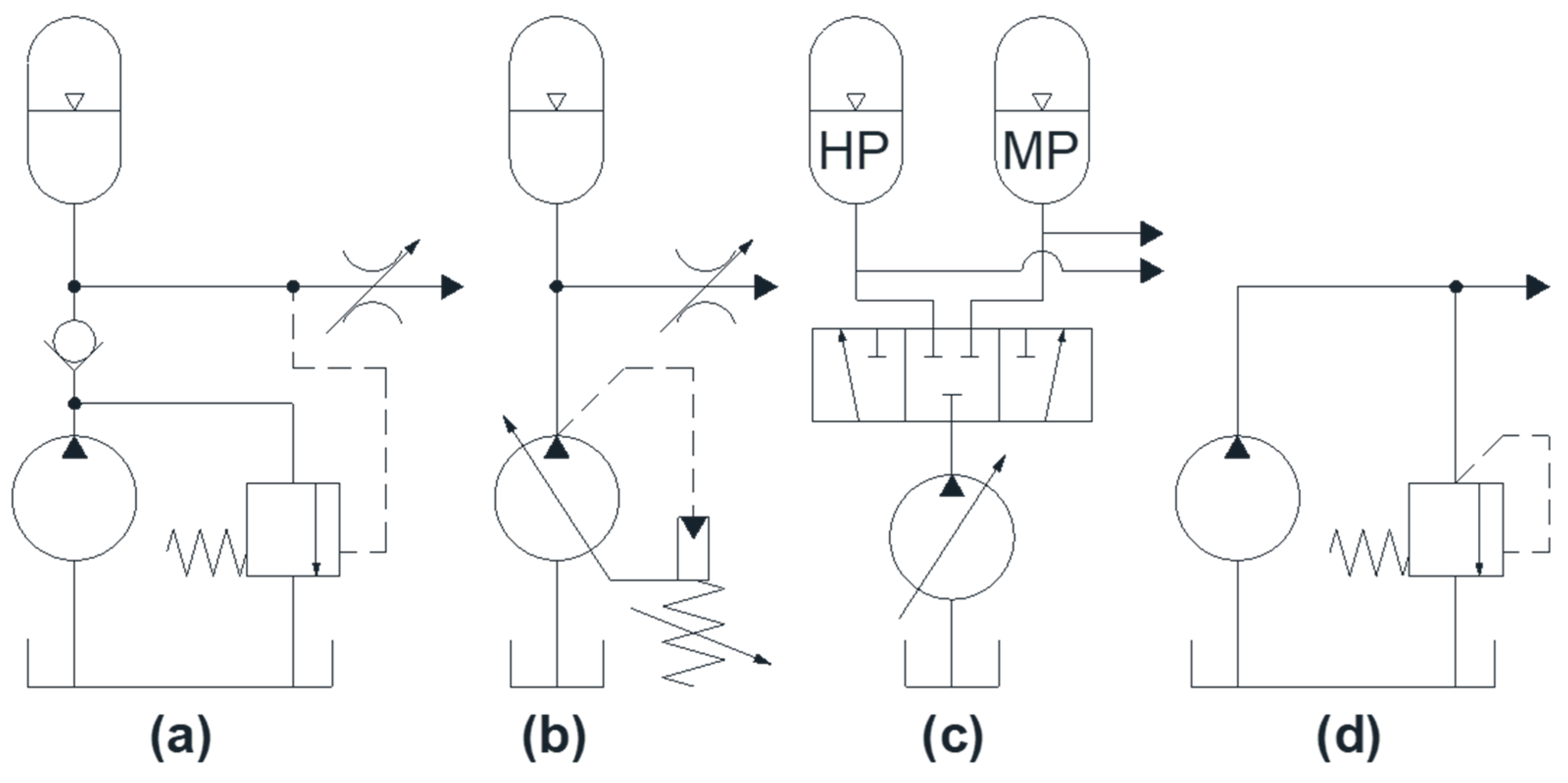
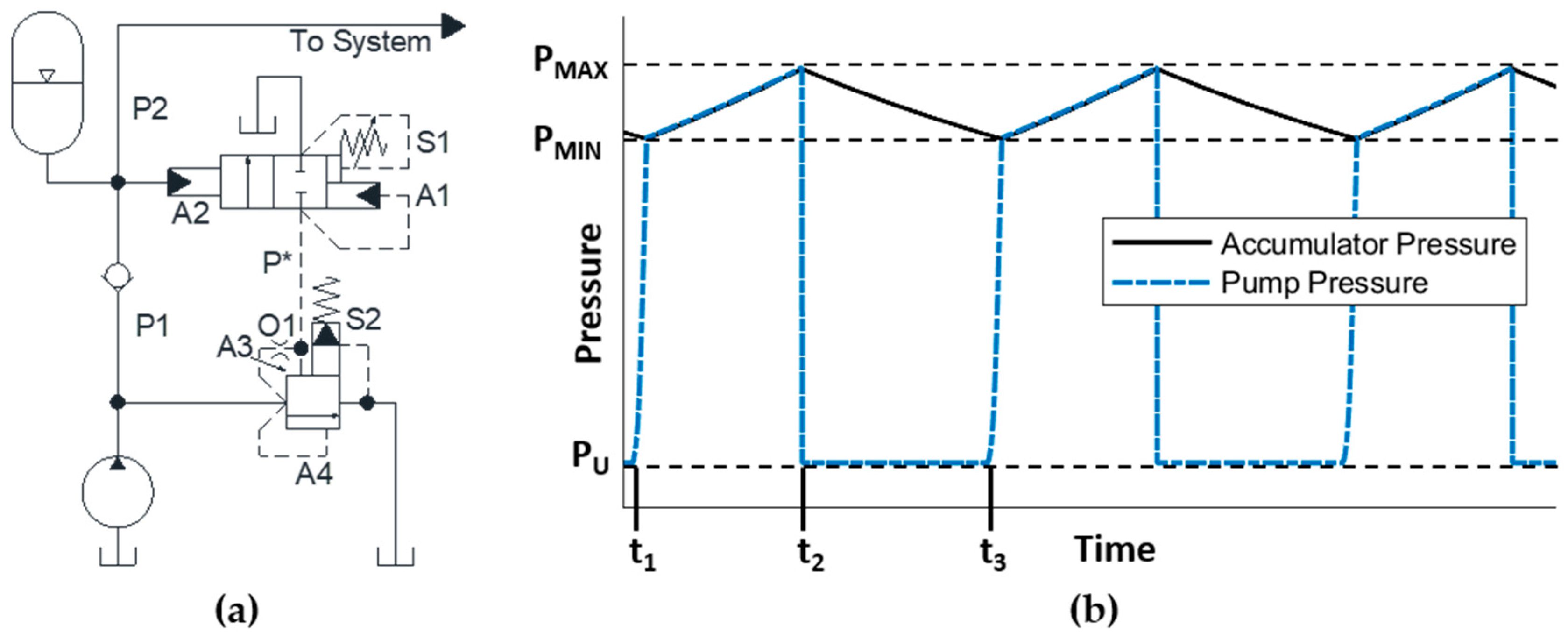
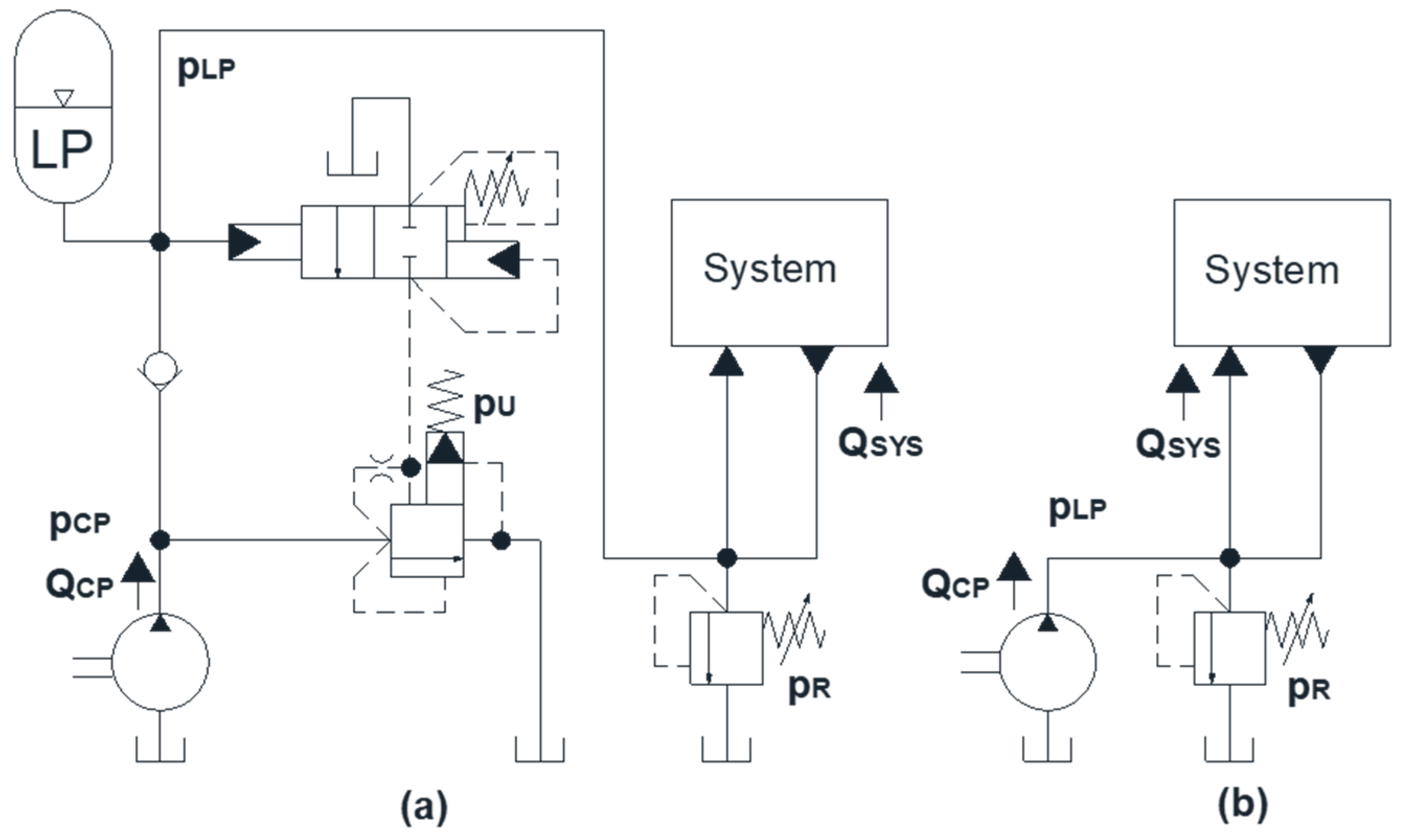
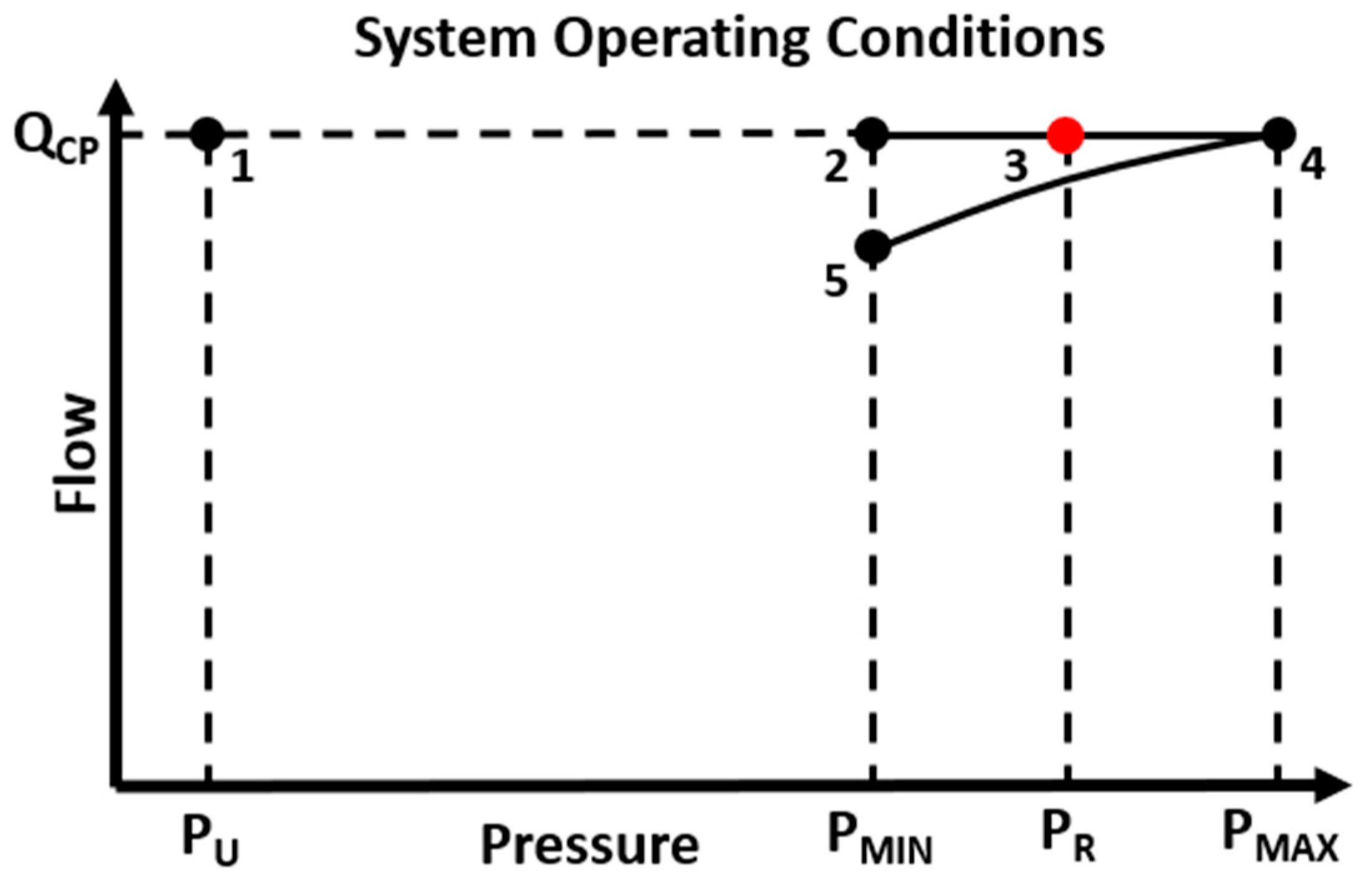
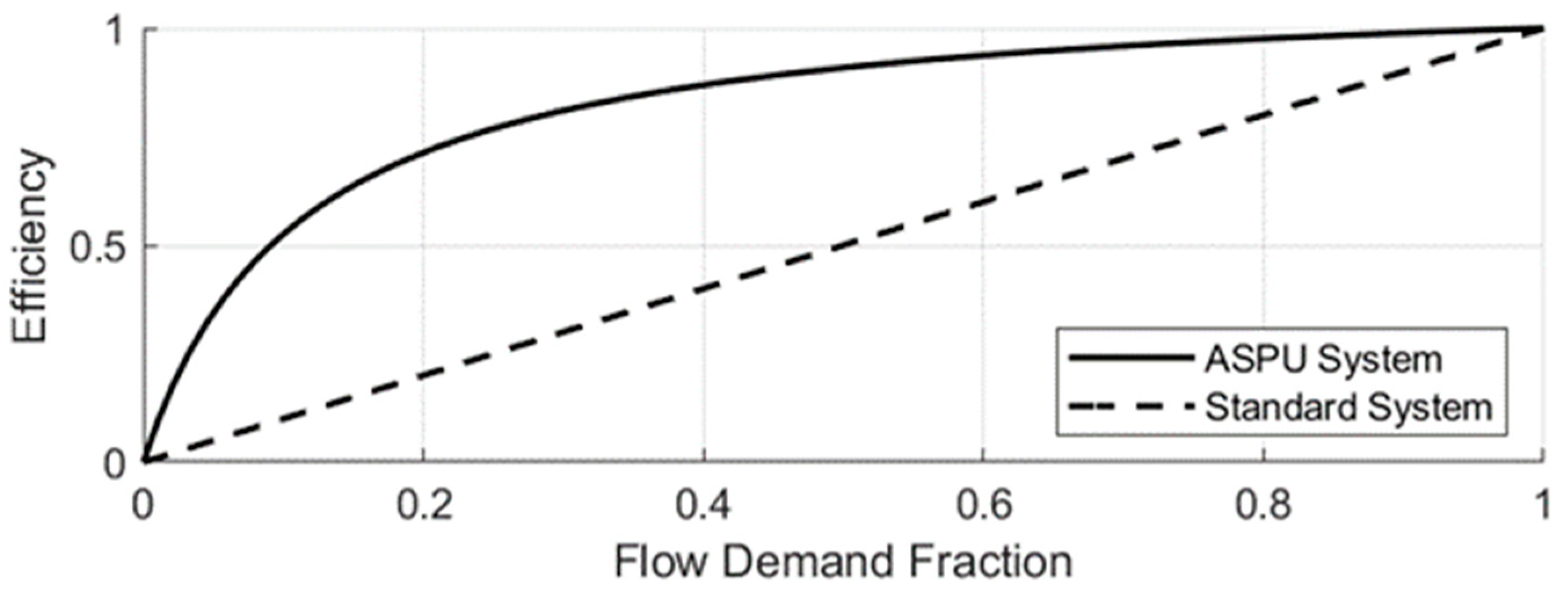
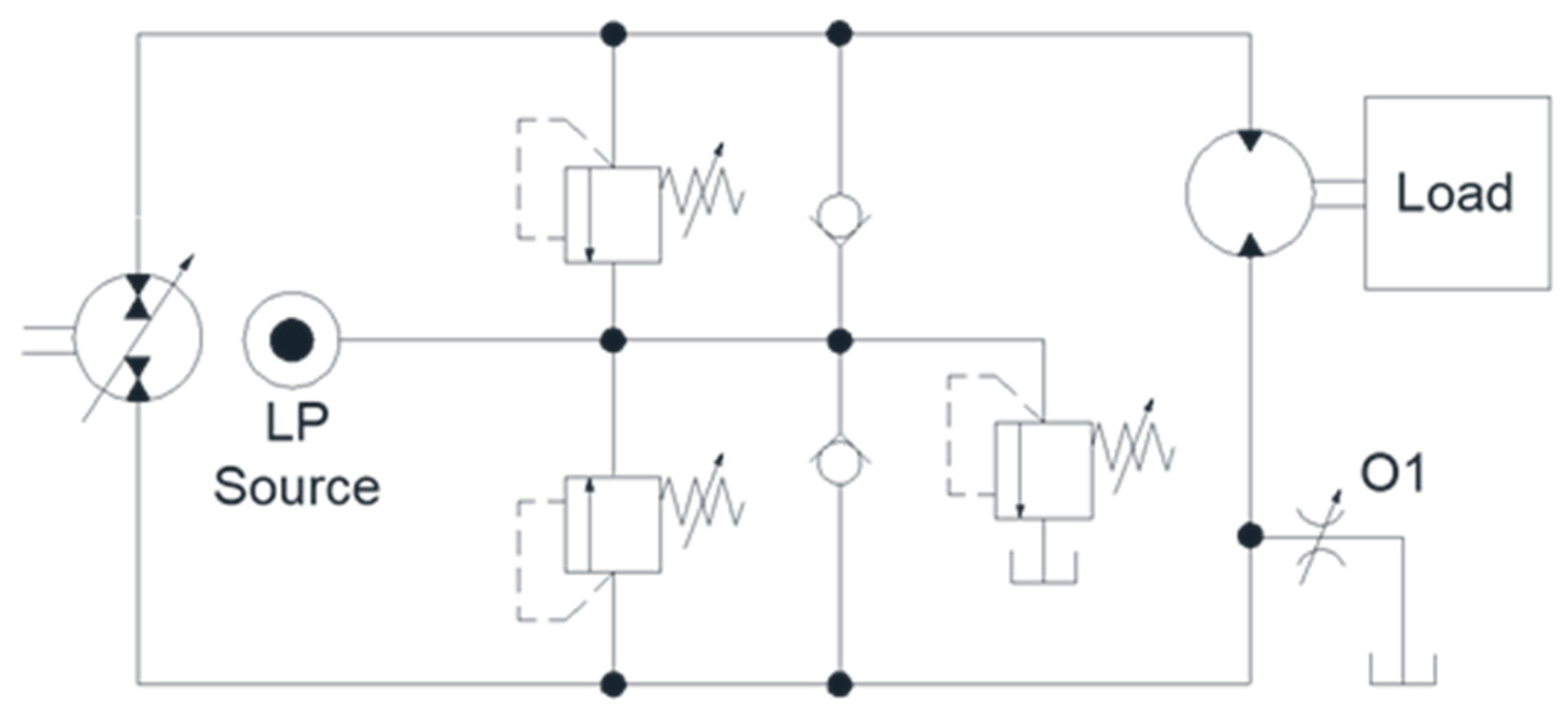
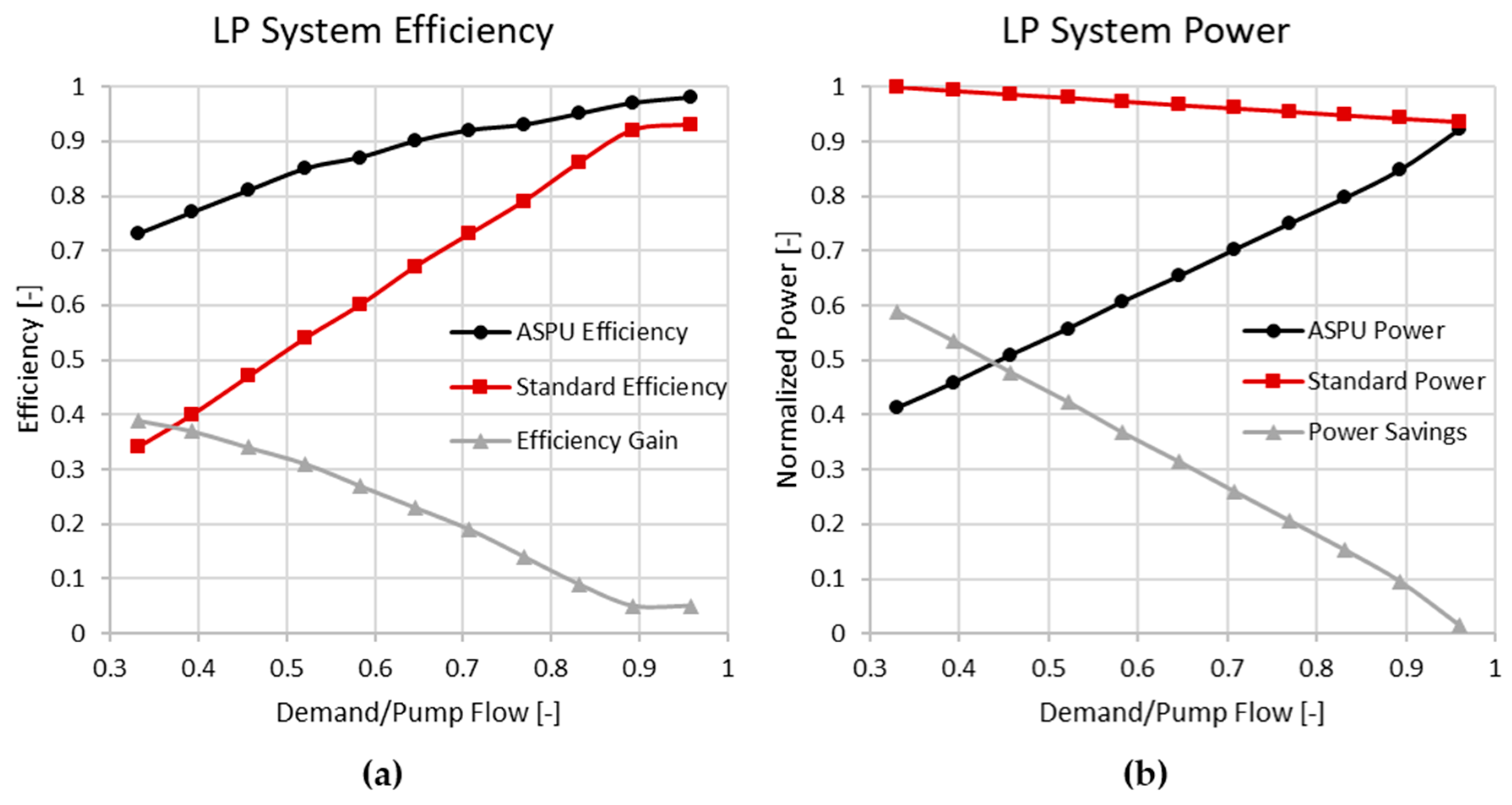
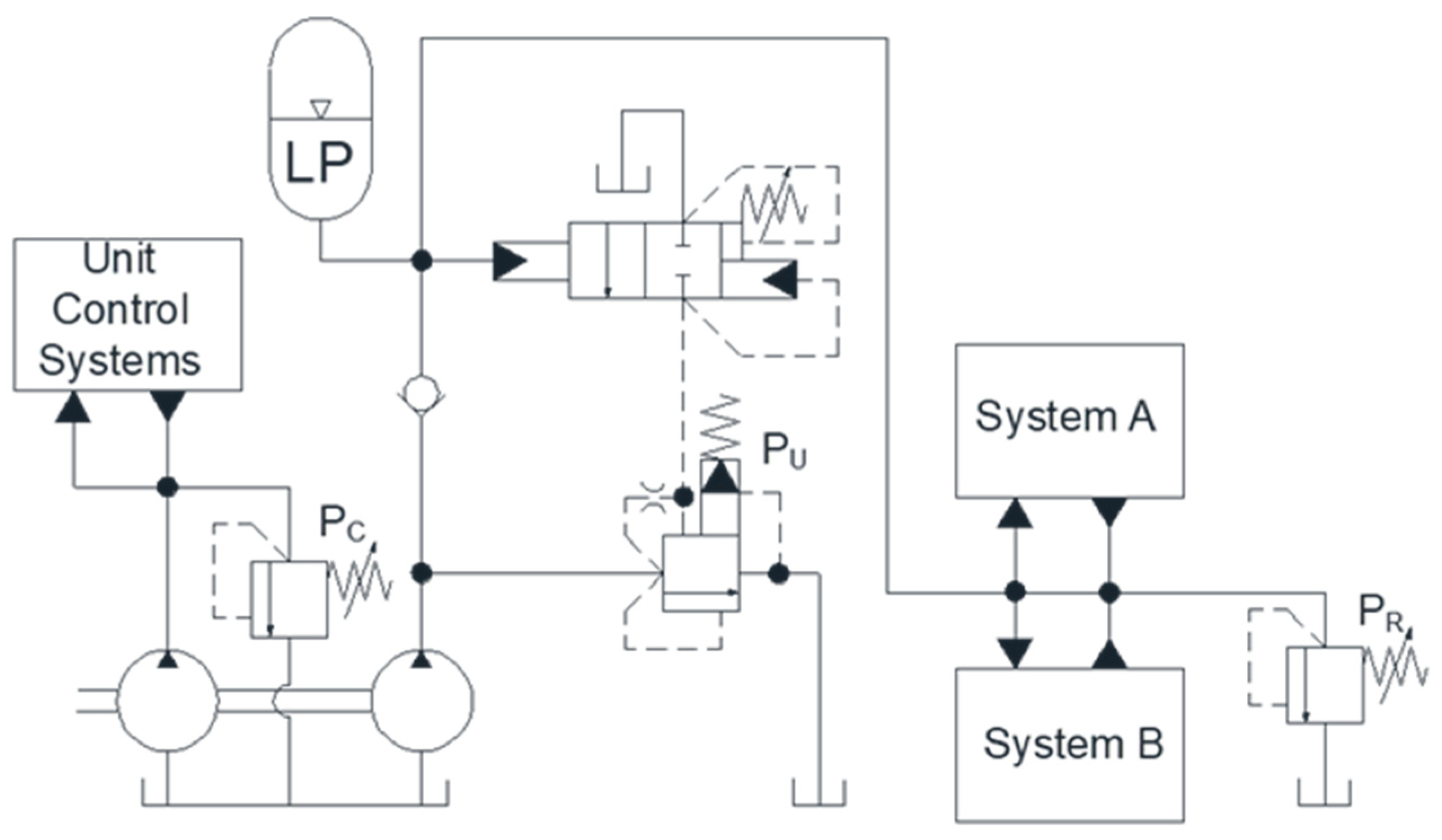


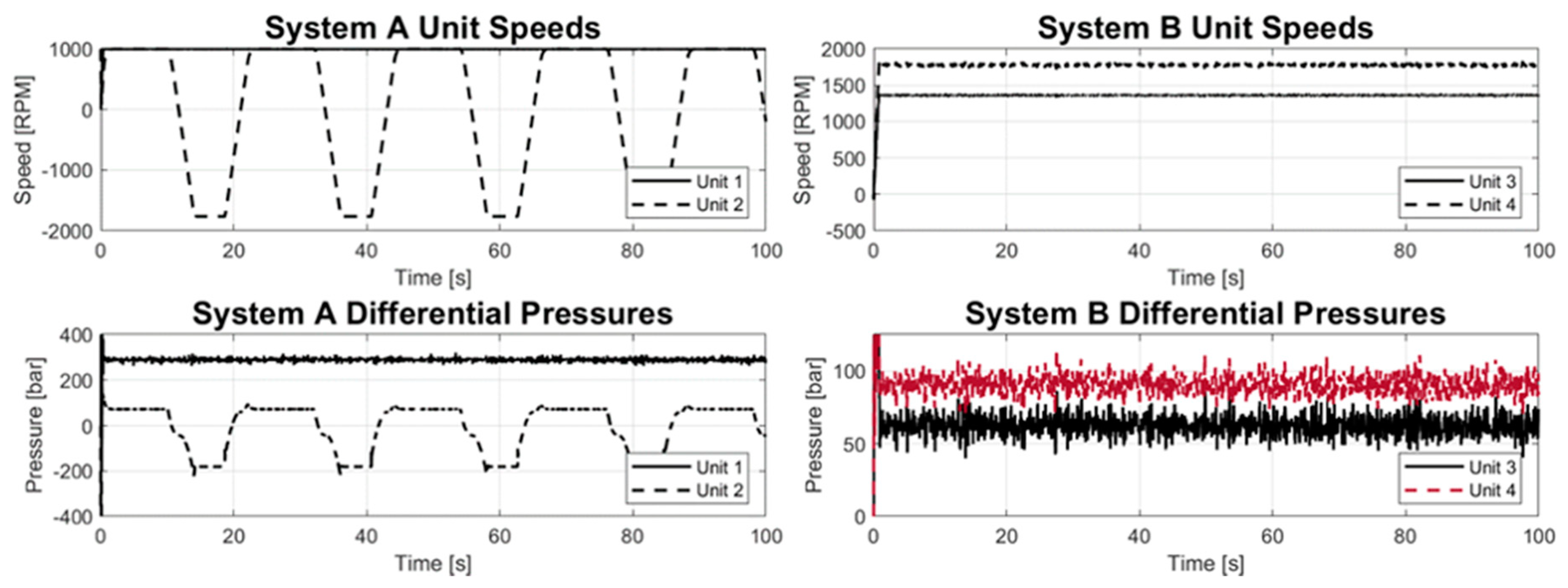

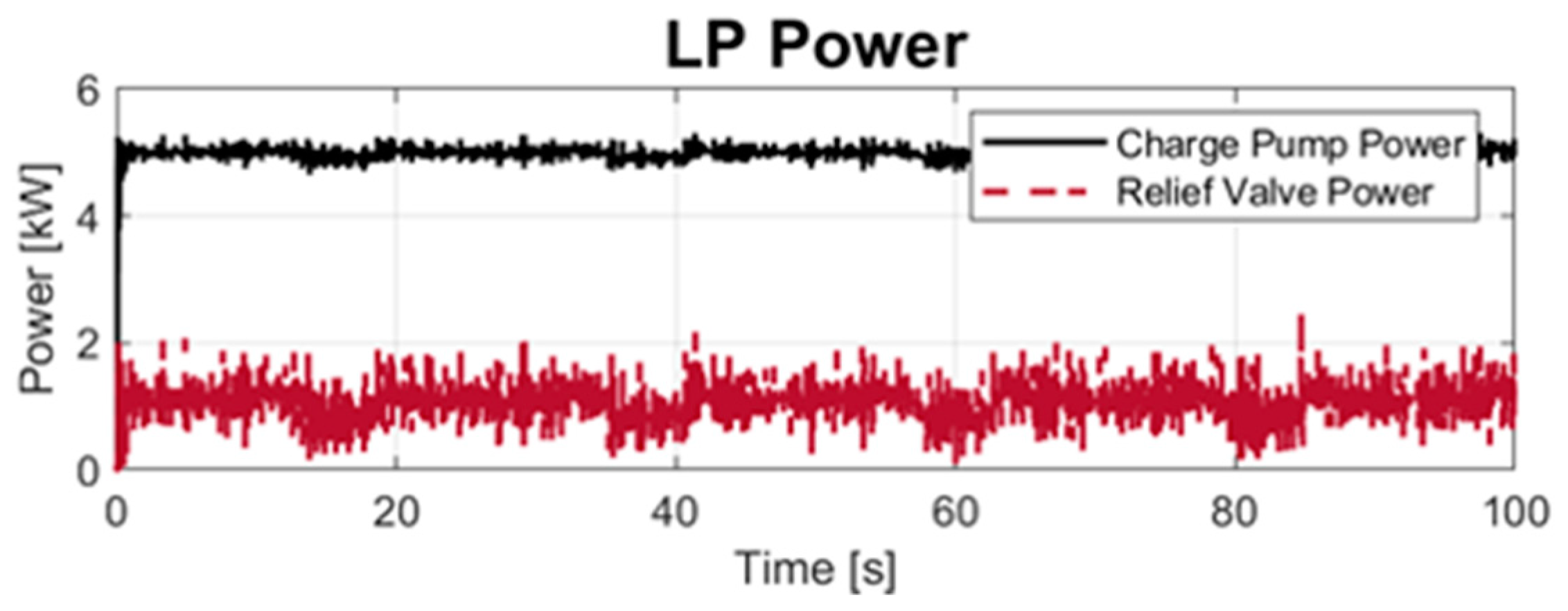
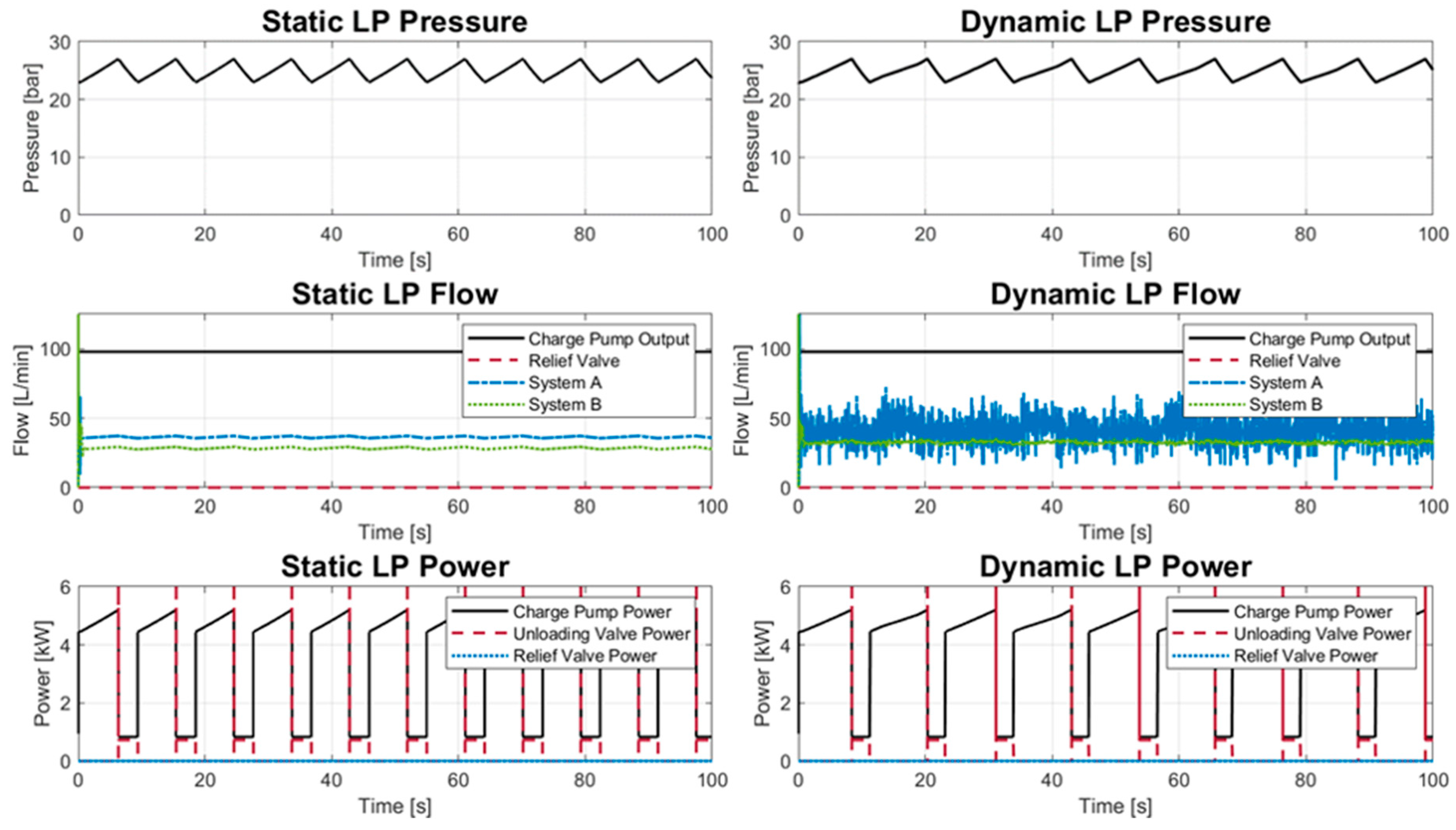
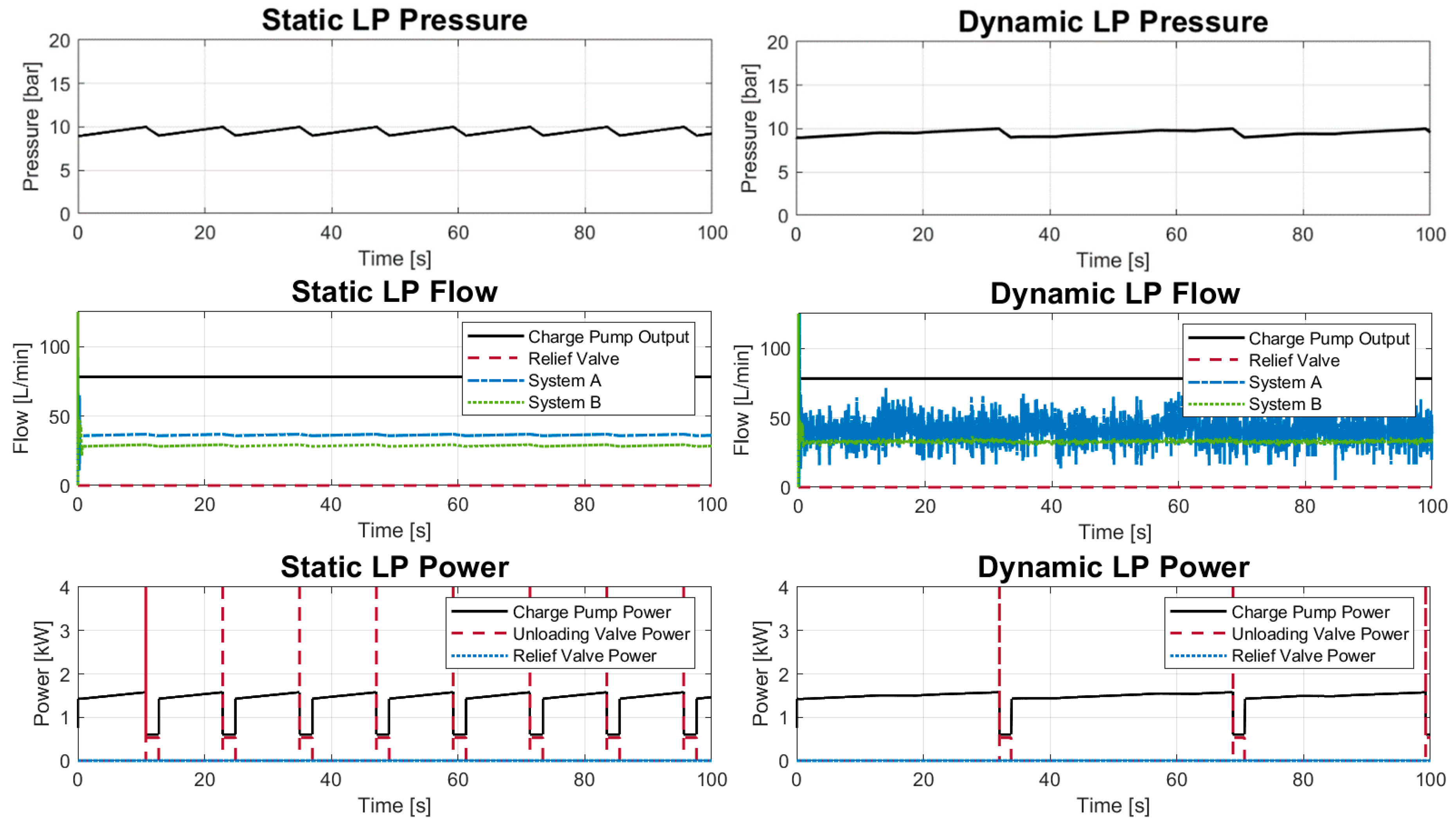

| Pump Size (cc) | Motor Size (cc) | |
|---|---|---|
| System A | 55 55 | 100 75 |
| System B | 55 | 100 75 |
| LP System | 40 | N/A |
| Pumps/Motors | ||
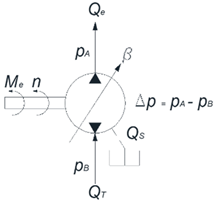 | (26) | |
| (27) | ||
| (28) | ||
| (29) | ||
| Check Valves | ||
 | (30) | |
| Relief Valves | ||
 | (31) | |
| Hydraulic Lines | ||
 | (32) | |
| Rotary Load | ||
 | (33) | |
| (34) | ||
| Fan Load | ||
 | (35) | |
| Accumulator | ||
 | (36) | |
| Static Operating Condition | Dynamic Operating Condition | |||
|---|---|---|---|---|
| Speed | Load | Speed | Load | |
| Unit 1 | 1000 RPM | N/A | −2000–1000 RPM | N/A |
| Unit 2 | 1000 RPM | 250 Nm | 1000 RPM | 350 + L(t) Nm |
| Unit 3 | β = 100% | 40 Nm | β = 100% | 80 + L(t) Nm |
| Unit 4 | 45 Nm | 90 + L(t) Nm | ||
| Average Speed (RPM) | Average Differential Pressure (bar) | |
|---|---|---|
| Unit 1 | 998.6 | 222.6 |
| Unit 2 | 1000.0 | 72.0 |
| Unit 3 | 1387.2 | 37.0 |
| Unit 4 | 1827.9 | 51.1 |
| Charge Pump | System A | System B | Relief Valve | |
|---|---|---|---|---|
| Flow (L/min) | 97.8 | 36.8 | 28.9 | 32.1 |
| Power (kW) | 5.11 (mechanical) | 1.92 | 1.51 | 1.47 |
| Pressure (bar) | 27.4 bar | |||
| Efficiency (%) | 67.2 hydraulic, 58.7 overall | |||
| System | Static Operating Conditions | Dynamic Operating Conditions | ||||
|---|---|---|---|---|---|---|
| Mechanical Power (kW) | Savings (%) | Hydraulic Efficiency (%) | Mechanical Power (kW) | Savings (%) | Hydraulic Efficiency (%) | |
| Reference | 5.11 | N/A | 67.2 | 4.99 | N/A | 75.7 |
| 15% ASPU Valve | 3.49 | 31.7 | 92.1 | 3.88 | 22.2 | 95.0 |
| 10% ASPU Valve With Split LP | 1.82 | 64.5 | 92.8 | 1.93 | 62.2 | 98.1 |
© 2019 by the authors. Licensee MDPI, Basel, Switzerland. This article is an open access article distributed under the terms and conditions of the Creative Commons Attribution (CC BY) license (http://creativecommons.org/licenses/by/4.0/).
Share and Cite
Stump, P.M.; Keller, N.; Vacca, A. Energy Management of Low-Pressure Systems Utilizing Pump-Unloading Valve and Accumulator. Energies 2019, 12, 4423. https://doi.org/10.3390/en12234423
Stump PM, Keller N, Vacca A. Energy Management of Low-Pressure Systems Utilizing Pump-Unloading Valve and Accumulator. Energies. 2019; 12(23):4423. https://doi.org/10.3390/en12234423
Chicago/Turabian StyleStump, Patrick M., Nathan Keller, and Andrea Vacca. 2019. "Energy Management of Low-Pressure Systems Utilizing Pump-Unloading Valve and Accumulator" Energies 12, no. 23: 4423. https://doi.org/10.3390/en12234423
APA StyleStump, P. M., Keller, N., & Vacca, A. (2019). Energy Management of Low-Pressure Systems Utilizing Pump-Unloading Valve and Accumulator. Energies, 12(23), 4423. https://doi.org/10.3390/en12234423






